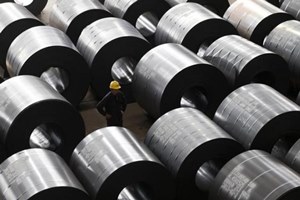The G20 has agreed to come together on reviving global trade for improving global economic growth. The proactive trade agenda was largely pushed by China in the recently concluded G20 Commerce Ministers’ meeting. The call to revive trade has come at a time when the G20 is a rather divided house on trade. More specifically, it is a divided house on trade matters with China.
It is ironical that the world’s largest socialist economy is calling for the global community to unite on curbing protectionism. And protective barriers are being considered most actively by countries that have traditionally been champions of free trade—the US and EU. In a sense, the global trade wheel has turned full circle where non-market economies like China are harping on free trade; and ‘market’ economies like the US and EU are unwilling to play ball.
This odd situation can be explained by the current circumstances in one particular industry that has taken global trade by storm: steel. The global steel industry is experiencing turbulent times that are largely responsible for the US and EU turning their backs on China and resorting to protective action. The situation has its roots in the tremendous expansion experienced by the Chinese finished steel industry during the last couple of decades. Fed by huge demand from its growing infrastructure, China began investing in sophisticated modern steel plants with large capacities. The emphasis was on production of finished steel and steel products that went into the huge rail infrastructure that China began building from around the beginning of the current century. Tonnes of steel also fed into the large automobile assembling plants that, practically, all global auto majors had built in China. They also sustained the real estate boom in mainland China, primarily, due to real estate being the only long-term asset capable of yielding appreciating returns in an economy where financial savings and linked instruments languished due to an underdeveloped capital market leaving precious little savings options for households.
[related-post]
Over time, as domestic infrastructure projects began producing lower and lower returns, and real estate became pricier and moved beyond middle class budgets, steel plants began developing idle capacities. In order to maintain the economic prospects of its steel industry, China focused attention outward. As outward investments from China increased, it began providing new outlets for Chinese steel, which was cheaper than the steel available in countries where China invested. A high point of this strategy was China’s embarking on ambitious regional connectivity projects, none more spectacular than the One-Belt-One-Road (OBOR). The OBOR, apart from its other objectives, is expected to create infrastructure projects that would provide outlets for surplus production from China’s steel plants to be absorbed in large quantities.
The tide began turning against China as Europe and American steel industries began pressing their governments for acting against Chinese steel. The former steel industries have indeed been hit hard in recent times. While their stagnation has much to do with their inability to enhance efficiency, they have been able to brand Chinese steel as the main culprit behind their dark days. At a time when industries across the world are cutting costs for protecting shares in shrinking markets, cheap Chinese steel has been a blessing for most industries using steel as raw materials.
The automobile industry is a pertinent example, which has been favouring lightweight steel built in China. This forced the US steel industry to lodge a complaint at the WTO against Chinese steelmakers for stealing the ‘trade secret’ of making lightweight steel. It is hardly surprising that Donald Trump’s maximum tirade against China has come out of Pennsylvania, where Pittsburgh is languishing from industrial stagnation, contributed in no small measure by large imports of cheap Chinese steel. The situation is pretty similar in Europe where the plight of the domestic steel industry is best evident from the hard days that Tata Steel’s overseas facilities are experiencing.
Both Europe and the US have now decided not to grant China ‘market economy’ status unless China addresses overproduction by its steel industry and stops flooding world markets with cheap steel. By not recognising China as ‘market economy’, Europe and US retain the flexibility in taking protective measures against Chinese imports, much faster and with less justification than they can against other WTO members.
The US and Europe versus China trade-off puts the G20 promise of reviving global trade on a rather sticky wicket. The US, Europe and China are important members of the G20. The possibility of them agreeing on a common G20 agenda for minimising protection and bringing down trade barriers is remote as that would mean US and Europe not acting against Chinese imports. The current political environment in both continents refrains their legislatures and executives from acting liberally on China. What this means, therefore, is the likelihood of the G20 action plan on reviving trade getting grounded well before it takes off.
The author is senior research fellow and research lead (trade and economic policy), Institute of South Asian Studies,
National University of Singapore.
Email: isasap@nus.edu.sg
Twitter: @Amitendu1.
Views are personal


